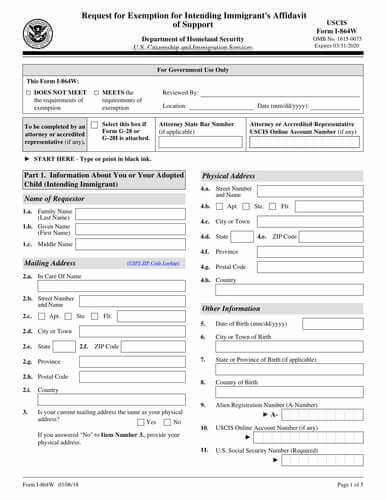A signed "Affidavit of Support" accepts financial responsibilities for a green-card seeking family member. It is also often referred to as Form I-864. The parties to this agreement are the sponsor and the United States of America. The sponsor's signature guarantees financial support for the visa applicant.
To keep things simple, if the prospective immigrant cannot support himself, the sponsor agrees to do so until legal permanent residency is achieved. This is a safety net if the immigrant runs into financial difficulties.
As a rule, the petitioners must:
- Complete the I-864 immigration form
- Collect Any Necessary Documents.
Even by many immigration attorneys, it's commonly known as one of the trickiest papers to complete.
This guide to the I-864 immigration form will tell you everything you need to know.
Why is the I-864 Immigration Form Important?
The Affidavit is a necessary part of the immigration paperwork the applicant must submit. Hence, the USCIS can see from this evidence that the applicant will not become a burden on the taxpayers of the United States after they move there.
The Affidavit is a financial document questioning the sponsor about their income, occupation, household size, and socioeconomic condition. The USCIS may thoroughly review this application, particularly the financial data. To prevent denial or RFE (Request for Evidence) from the USCIS, keep reading our guide to avoid common mistakes when filling out the I-864 Immigration Form.
What Information is Required on the I-864 Immigration Form?
Sponsoring a family member's entry into the United States requires filling out an I-864 Immigration Form to prove they won't rely on welfare or other forms of government support after they arrive in the country.
For this form to be valid, the sponsor must be the same person who submitted the visa petition for the intended immigrant. A new sponsor may sign the petition in place of a deceased one. If the petitioner has passed away, another sponsor can sign on their behalf. A third party must sign a separate form as a joint sponsor if the primary or secondary sponsor cannot afford to pay for everything.
To complete the form, you'll need the primary immigrant's name and address, employer's information, annual salary, and household members’ names who want to contribute financially to the sponsorship. In addition, if you've ever sponsored somebody financially before, you'll need to include that information in Form I-864.
The primary immigrant is responsible for submitting the original Form I-864, proof of the sponsor's income, and copies of the form for all accompanying family members. For the form to be valid, it must be signed with black ink.
This is an essential aspect of the immigration process because it verifies that residents who'd love to settle permanently in the United States have sufficient funds.
Common Issues with the I-864 Immigration Form
In this section, we'll look at some of the most common reasons for RFEs after submitting an I-864 form for an immigrant visa application. Please find helpful hints and instructions for sponsors and immigrants to follow:
- Not the amount of taxes the sponsor had to pay in the previous year, but rather their current annual income should be listed. Their yearly earnings estimate should include all of their taxable and nontaxable income, as well as any additional federal or state benefits they receive (aside from SSI and TANF).
- Even if the sponsor's current income is significantly lower, they must give the amount they declared on their taxes the previous year, even if it was a joint return.
- To comply with the rules, it is necessary to include the sponsor, the sponsor's spouse, any unmarried children under the age of 21, dependents claimed on the most recent tax return, the intending immigrant, and any derivatives accompanying the principal beneficiary when determining the size of the household.
- Only if income is insufficient can assets be considered, and professionals should be wary of overvaluing assets or include ones that are not permitted.
This list is meant as a primer for filling out the I-864 form. Still, sponsors and immigrants should always refer to the most recent version of the form and associated government guidelines and regulations.
Make sure your forms are error-free to avoid any unnecessary delays or rejections. There are two common ways to fix an incorrect form: getting a new form or making the necessary changes to the one you have. If you make modifications to the form, highlight them to show that they were done on purpose.
Check the instructions for any forms that need special processes for fixing mistakes. It's also a good idea to get in touch with the appropriate authority or organization to clarify how to make the necessary corrections or submit the required supporting materials for the form.
In summary, fixing mistakes on a form is inconvenient but necessary to prevent adverse effects. Therefore, make a quick call to the proper authorities, heed their guidance, and take precautions to avoid mistakes altogether.
Last Updated 03/27/23 04:42:56AM


 Form I-864W | Request for Exemption for Intending Immigrant's Affidavit of Support
Form I-864W | Request for Exemption for Intending Immigrant's Affidavit of Support